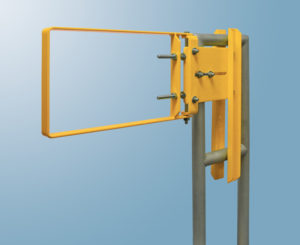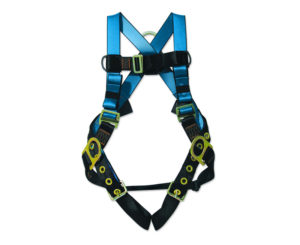
Large scale construction projects, like the recently completed reconstruction of the Tappan Zee Bridge in New York, can take years to complete. These megaprojects involve hundreds of workers from a number of professions and companies working on a wide variety of surfaces with various materials. There’s a lot to consider. But while aiming toward a completion deadline and staying on budget are significant concerns, keeping workers safe should be every project’s top priority. Today there are a multitude of fall safety solutions for large scale construction sites. From traditional fall protection devices like a harness and lanyards, to new technologies like drones, there’s a myriad of ways to up your fall safety protocol—no matter how big the job.
1. Communication
One of the biggest challenges of large scale construction projects is communication. These projects usually cover expansive areas, typically putting more physical distance between site workers, supervisors, and project managers than your average commercial site. Even when workers are near one another, construction sites are loud and disruptive, making communication difficult. And unfortunately, poor communication can lead to mistakes as well as accidents
The good news is, technology has come very far, enabling workers to send and receive pertinent information without leaving their posts.
Photo & Video Messaging
Remote photo and video communication via smartphones keeps workers safe by efficiently addressing potential issues and hazards as they arise. When work needs to come to a halt due to a safety issue, photos and videos provide detailed information such as the onsite GPS location, the angle of an impediment, or the visual condition of concerning materials or malfunctioning equipment, so you can resolve the problem as quickly and efficiently as possible. Competent persons or supervisors can review photos and videos from their current location and instruct workers on how to proceed safely—if they may proceed at all.
Construction Software
Construction software further enhances remote communication by linking workers, supervisors, and project managers together on one cloud-based, mobile-accessible network. Construction software aids the accuracy of information sharing, whether on-site or off-site, across all levels for large scale construction workers. Supervisors and project managers can provide real-time alterations to design plans and simultaneously notify workers of changes. Administratively, construction software provides data tracking and analysis to best manage productivity, cost efficiency, deadlines, safety, and documentation.
Drones
Drones are widely used throughout the construction industry. Directed by a safely grounded pilot, drones inspect and monitor dangerous remote areas at construction sites. Drones can capture details with high-resolution cameras as well as assess problem areas with infrared cameras. While hovering over a construction site, a drone can map the entire area and relay the information directly to project-mapping software.
2. Fall Protection
Implementing both active and passive fall protection at large scale construction sites is paramount. Workers frequently find themselves in precarious positions as they get their job done, from being near excavation sites, working at heights of six feet or higher, or near hazardous equipment. Depending on the nature of the job at hand, you’ll need to employ either active or passive fall protection—or a combo of both.
Passive Fall Protection
Passive devices like a safety gate, guardrails, toe rails, and barriers can be installed as part of the worksite to protect workers near exposed edges, holes, and raised platforms. Once installed, passive devices require no additional interaction from workers, allowing them to go about their business. Passive devices must meet OSHA requirements to withstand the worksite environment, and fortunately, can often be either portable or permanent, so you can use and reconfigure them as the job site changes. Often passive safety needs can be unique to each large scale project, making custom products, like a safety gate built to your unique specifications, a viable solution.
![]() Active Fall Protection
Active Fall Protection
Active fall protection, like restraint systems and fall arrest systems, requires participation from workers as part of their usage. Restraint systems use a harness and lanyards attached to anchorage points to prevent a worker from falling. Since these restraint systems will prevent a fall altogether, they are often preferred whenever the worksite allows for it. However, a restraint system can limit workers to a small radius, making them somewhat impractical for large scale construction sites.
On the other hand, a fall arrest system allows a fall to occur but prevents the worker from striking the surface below them. Like a restraint system, a fall arrest system consists of a harness and lanyards, but the equipment is engineered to withstand the forces associated with stopping falls. A restraint system is usually preferable; however, in large scale construction this isn’t always feasible. This often makes fall arrest systems the best choice for fall safety when it comes to a wide variety of applications in large constructions.
3. Construction Automation
Every day at large scale construction sites, workers put themselves at high risk of injury by working closely with a wide array of moving parts. Heavy equipment, dangerous materials, human error—there are lots of variables that can affect fall safety.
Construction automation has the potential to dramatically improve safety by utilizing machines to do hazardous, repetitive jobs. Self-driving vehicles and robots are making monumental gains with ongoing improvements in engineering and software. Automation has already improved safety conditions in factories, warehouses, and the mining industry.
4. Prefabrication
Big projects like skyscrapers, bridges, stadiums, and transportation hubs are usually built with recurrent, cumbersome materials. Rather than start from scratch, the use of prefabricated pieces can minimize worker fatigue and improve site safety by reducing onsite tasks. Prefabricated pieces can be designed and built-in factory settings, using automated systems rather than straining a limited workforce of skilled workers. Use of prefabrication is not only safer for large scale construction, but also cost-effective and time-efficient.
Modern advancements in the construction industry are making large scale construction projects safer for skilled workers. Now, you can approach a challenging, large scale job knowing that a multitude of fall safety solutions are available to keep your workers happy and healthy while on the job. From simple additions like a safety gate and harness and lanyards to the more technologically advanced solutions, large scale construction projects can be executed in a safer manner than ever before.







